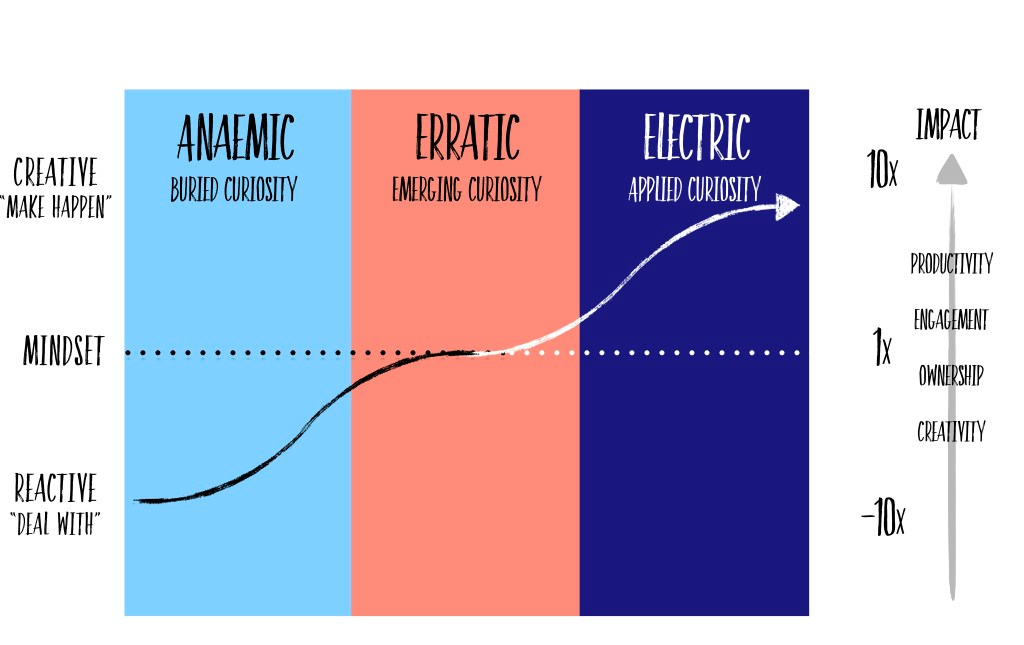In my last post, we looked at the barriers to curiosity thriving at work. Now, let’s have a look at what a ‘curious culture’ looks, sounds and feels like.
When I look around and find organisations that have what I reckon are curious cultures, the one thing I notice is the energy in the place. You can absolutely feel it. It might not be written down in company policy, but it’s definitely in the air.
One successful tech company I work with has got it in spades. Whenever I visit them, if I just sit and observe for a while, this is what I’ll notice people doing:
- Debating ideas in the hallway
- Asking plenty of questions
- Sharing what they’ve learned from the last project, or from a conference they’ve been to
- Taking new ideas and testing them out there and then
- Working beyond ‘finish time’ because they’re onto something.
What I don’t see is people:
- Sitting submissively in meetings while the leader holds the talking stick
- Bandying around new ideas at the coffee machine, but no-where else
- Holding back on sharing new learning and ideas
- Clocking 9 to 5.
Have you ever worked in a place where it’s more of the latter and less of the former? Not particularly live-giving, right? One of my earliest jobs was when I worked in a bakery during the school holidays. My job was simply and solely to cook up massive quantities of pie meat. I wanted to learn how they made all the different pastries and cakes, but I was told in no uncertain terms that my job was to stay in my corner and do what I was told. Curiosity smothered, I kept my head down and counted the hours. The bakery was a well-oiled production machine. If everyone did their jobs, it was a good day’s work.
I call workplace cultures like this ‘anaemic‘. The dictionary defines this as “lacking in colour, spirit or vitality.” That’s certainly what it felt like. Anaemic cultures are not necessarily bad, but they’re no place for curiosity to thrive. In an ever-changing world, well-oiled machines aren’t enough to enable adaptation and innovation. We need room for curiosity to emerge and breathe.
“You can’t see the whole sky through a bamboo tube.”
– Japanese proverb
One of the most common questions I hear from leaders is “How do I get my people to be more innovative?” Most leaders end up with teams that have pockets of innovation, but the overall centre of gravity is still weighted towards maintaining the status quo. They end up with islands of brilliance in a sea of ‘meh’.
Here, curiosity is erratic. It struggles to get a permanent toehold. Ideas surface, and that’s what they stay: just ideas, unexplored, unapplied and often abandoned. People tell stories about when ‘so and so’ did ‘such and such’ and changed the game. But these stories are told because they’re the exceptions, not the rule. The primary reason is due to the barriers to curiosity we’ve looked at before.
Rather than isolated islands of brilliance, you want a whole archipelago, joined up with bridges. Here, with every employee’s curiosity engaged, you get a culture that shines brightly. It’s electric. It’s the feeling of the static in the air just before a thunderstorm. Humming, buzzing, charged.
In electric cultures, ideas don’t just emerge, they’re actively applied. People and teams engage in a constant cycle of ideation, testing, learning, and sharing. The difference between erratic and electric cultures is this: electric cultures have curiosity and learning at their core.
Here’s a map that tracks the three stages of curious cultures:
Where does your team or organisation sit on this curve?
The critical shift is to help your people move from a ‘reactive‘ mindset to a ‘creative‘ one. A reactive mindset focuses on maintaining the status quo. Anything that upsets stability is a problem to deal with, and make go away, so we can get back to ‘normal’. Curiosity has no room to breathe here.
On the other hand, a creative mindset focuses not on making problems go away, but on creating outcomes rooted in a sense of higher vision and purpose. To do that, curiosity has to take front and centre stage.
When you’re past the tipping point on this journey, you’re on a virtuous cycle. Research shows that people (and by extension, cultures) with higher levels of curiosity:
- learn more, and learn better
- innovate faster
- continue to invest in learning (driving more curiosity)
- are more ‘distress tolerant’ i.e. they’re more tolerant of ambiguity and uncertainty
No wonder more and more companies are hiring for curiosity. Check out Bank of New Zealand’s career’s video. Want to play? Better bring your best curiosity game.
Wherever you sit on the curve, it’s likely that there’s an opportunity to shift your culture further towards the right. What might it take to make this shift?
In my next post, I’ll share some ideas for making that happen.
Piqued your interest? Check out my Leading Curiosity workshop or get in touch for a chat.
Like this post? You’re only getting half the story. Sign up to my ‘Fresh Thinking’ newsletter, delivered monthly to your inbox.
Are you a Change Maker? Learn more about my Change Makers programme, including next intake dates.



2 thoughts on “How Curious is Your Culture?”
Comments are closed.